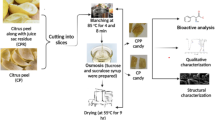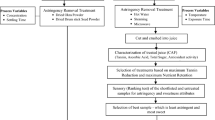Abstract
The present study was focused on the development of nutritionally enriched ketchup (Nutri-ketchup) from acerola and tomato and evaluation of the effect of blending and processing on physicochemical characteristics, phytonutrients retention, antioxidant activity and sensorial quality. Acerola and tomato pulps blended in various ratios viz. 100:0, 75:25, 50:50, 25:75 and 0:100 were used for the preparation of five formulations of ketchup and compared with commercially available tomato ketchup. The retention of phytonutrients varied among formulations viz. ascorbic acid- ~18–29 %, anthocyanins- ~17–25 %, phenolics- ~11–70 %, flavonoids- ~24–42 %, lycopene- ~24–33 % and carotenoids- ~23–34 %. Antioxidant capacity of 80 % methanol extract and ascorbic acid fraction of the formulations evaluated using DPPH and ABTS assays showed higher activity than the commercial sample. Ketchup prepared from acerola and tomato blend of 75:25 showed the best overall quality, while all the other formulations were also sensorily acceptable.



Similar content being viewed by others
References
Abushita AA, Daood HG, Biacs PA (2000) Change in carotenoids and antioxidant vitamins in tomato as a function of varietal and technological factors. J Agric Food Chem 48:2075–2081
AOAC (2000) Official methods of analysis, 18th edn. Association of Official Analytical Chemists, USA (Chapter 37)
Brito ESD, Arauio MCPD, Alves RE, Carkeet C, Clevidence BA, Novotny JA (2007) Anthocyanins present in selected tropical fruits: Acerola, Jambolao, Jussara, and Guajiru. J Agric Food Chem 55:9389–9394
Capanoglu E, Beekwilder J, Boyacioglu D, Hall R, Vos RD (2008) Changes in antioxidant and metabolite profiles during production of tomato paste. J Agric Food Chem 56:964–973
Cavalcante IHL, Beckmann MZ, Martins ABG, Campos MCC (2007) Preliminary selection of acerola genotypes in Brazil. Fruits 62:27–34
Crozial A, Lean MEJ, McDonald MS, Black C (1997) Quantitative analysis of the flavonoid content of commercial tomatoes, onions, lettuce, and celery. J Agric Food Chem 45:590–595
Dewanto V, Wu X, Adom KK, Liu RH (2002) Thermal processing enhances the nutritional value of tomatoes by increasing total antioxidant activity. J Agric Food Chem 50:3010–3014
Falcao AP, Chaves ES, Flacao LD, Gauche C, Barreto PLM, Bordignon-Luiz MT (2009) Rheological behavior and color stability of anthocyanins form Merlot (Vitis vinifera L.) and Bordo (Vitis Labrusca L.) grapes in a jam model system. Food Sci Technol 29(4):857–862
Freitas CASD, Maia GA, Costa JMCD, Figueiredo RWD, Sousa PHM (2006) Acerola: production, composition, nutrition aspects and products. R Bras Agrociencia, Pelotas 12:395–400
Gahler S, Otto K, Bohm V (2003) Alterations of Vitamin C, total phenolics, and antioxidant capacity as affected by processing tomatoes to different products. J Agric Food Chem 51:7962–7968
George S, Tourniairea F, Gautire H, Goupy P, Rock E, Veyrat CC (2011) Changes in the contents of carotenoids, phenolic compounds and vitamin C during technical processing and lyophilisation of red and yellow tomatoes. Food Chem 124:1603–1611
Giusti MM, Wrolstad RE (2001) Unit F1.2. Anthocyanins. Characterization and measurement with UV-visible spectroscopy. In: Wrolstad RE, Schwartz SJ (eds) Current protocols in food analytical chemistry. Wiley, New York, pp 1–13
Kanawati B, Paul VVS, Herrmann C, Schaffner AR, Kopplin PS (2011) Mass spectrometric stereoisomeric differentiation between α- and β- ascorbic acid 2-O-glucosides. Experimental and density functional theory study. Rapid Commun Mass Spectrom 25:806–814
Kaur D, Sharma R, Wani AA, Gill BS, Sogi DS (2006) Physicochemical changes in seven tomato (Lycopersicon esculentum) cultivars during ripening. Int J Food Prop 9:747–757
Kumar K, Ray AB (2016) Development and shelf-life evaluation of tomato-mushroom mixed ketchup. J Food Sci Technol 53(5):2236–2243
Lima VLAG, Melo EA, Maciel MIS, Prazeres FG, Musser RS, Lima DES (2005) Total phenolic and carotenoid contents in acerola genotypes harvested at three ripening stages. Food Chem 90:565–568
Liu RH (2004) Potential synergy of phytochemicals in cancer prevention: mechanism of action. J Nutr 134:3479S–3485S
Martinez-Valverde I, Periago MJ, Provan G, Chesson A (2002) Phenolic compounds, lycopene and antioxidant activity in commercial varieties of tomato (Lycopersicum esculentum). J Sci Food Agric 82:323–330
Mezadri T, Galvez PA, Mendez HD (2005) Carotenoid pigments in acerola fruits (Malpighia emarginata DC.) and derived products. Eur Food Res Technol 220:63–69
Mezadri T, Villano D, Fernandez-Pachon MS, Garcia-Parrilla MC, Troncoso AM (2008) Antioxidant compounds and antioxidant activity in acerola (Malpighia emarginata DC.) fruits and derivatives. J Food Comp Anal 21:282–290
Oliveira LS, Rufino MS, Moura CFH, Cavalcanti FR, Alves RE, Miranda MRAD (2011) The influence of processing and long-term storage on the antioxidant metabolism of aceorla (Malpighia emarginata) puree. Braz J Plant Physiol 23(2):151–160
Oszmianski J, Woidylo A (2009) Effects of blackcurrant and apple mash blending on the phenolics contents, antioxidant capacity, and colour of juices. Czech J Food Sci 27(5):338–351
Re R, Pellegrini N, Proteggente A, Pannala A, Yang M, Rice-Evans C (1999) Antioxidant activity applying an improved ABTS radical cation decolorization assay. Free Radical Biol Med 26:1231–1237
Rekha MN, Chauhan AS, Prabhashankar P, Ramteke RS, Rao GV (2013) Influence of vegetable purees on quality attributes of pastas made from bread wheat (T. aestivum). CyTA-J Food 11(2):142–149
Righetto AM, Netoo FM, Carraro F (2005) Chemical composition and antioxidant activity of juices from mature and immature acerola (Malpighia emarginata DC). Food Sci Technol Int 11:315–321
Rosso VVD, Mercadante AZ (2005) Carotenoid composition of two Brazilian genotypes of acerola (Malpighia punicifolia L.) from two harvests. Food Res Int 38:1073–1077
Rosso VVD, Mercadante AZ (2007a) The high ascorbic acid content is the main cause of the low stability of anthocyanins extracts from acerola. Food Chem 103:935–943
Rosso VVD, Mercadante AZ (2007b) Evaluation of colour and stability of anthocyanins from tropical fruits in an isotonic soft drink system. Innov Food Sci Emerg Technol 8:347–352
Sharma SK, Maguer LM (1996) Kinetics of lycopene degradation in tomato pulp solids under different processing and storage conditions. Food Res Int 29(3–4):309–315
Singleton VL, Rossi JA Jr (1965) Colorimetry of total phenolics with phosphomolybdic-phosphotungstic acid reagents. Am J Enol Vitic 16:144–158
Slimestad R, Fossen T, Verheul MJ (2008) The flavonoids of tomatoes. J Agric Food Chem 56:2436–2441
Srivastava S, Srivastava AK (2015) Lycopene; chemistry, biosynthesis, metabolism and degradation under various abiotic parameters. J Food Sci Technol 52(1):41–53
Turkmen N, Sari F, Velioglu SY (2005) The effect of cooking methods on total phenolics and antioxidant activity of selected green vegetables. Food Chem 93(4):713–771
Vendramini LA, Trugo LC (2000) Chemical composition of acerola fruit (Malpighia punicifolia L.) at three stages of maturity. Food Chem 71:195–198
Zhishen J, Mengcheng T, Jianming W (1999) The determination of flavonoid contents in mulberry and their scavenging effects on superoxide radicals. Food Chem 64:555–559
Zhou K, Yu L (2004) Antioxidant properties of bran extracts from trego wheat grown at different locations. J Agric Food Chem 52:1112–1117
Acknowledgments
The authors are grateful to Director, CSIR-CFTRI, Mysore for extending facilities for this study. The authors also acknowledges technical assistance of Mr. Padmere Mukund Lakshman and Mr. Harish Raj V, Central Instruments Facility & Services, CFTRI.
Author information
Authors and Affiliations
Corresponding author
Rights and permissions
About this article
Cite this article
Prakash, A., Prabhudev, S.H., Vijayalakshmi, M.R. et al. Implication of processing and differential blending on quality characteristics in nutritionally enriched ketchup (Nutri-Ketchup) from acerola and tomato. J Food Sci Technol 53, 3175–3185 (2016). https://doi.org/10.1007/s13197-016-2291-z
Revised:
Accepted:
Published:
Issue Date:
DOI: https://doi.org/10.1007/s13197-016-2291-z




